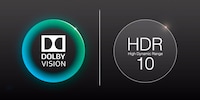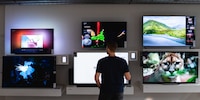

Are there decent TVs for less than CHF 1,000.–? Yes, there are
New arrivals. Innovations. Exciting technologies. As a digitec editor, that’s what I’m all about. And I find this in the most expensive televisions on the market. However, many people don’t want to spend that much money. Let’s take a look at good TVs that don’t cost much.
«Luca, I need a new TV. Any recommendations?»
That's a question I'm often asked. More often than Dustin Hoffman can count «Rain Man» in the 1988 classic. Here are my current favourites. The usual reaction: A resigned «Oh, that's expensive». Most people aren’t willing to spend more than a thousand francs on a new TV.
A thousand francs. That’s not much for a TV. There are smartphones that cost more – and they have a screen diagonal of about six inches. However, I’m up for the challenge. Let's see what our TV range has to offer that costs less than a thousand francs...
...and is decent at the same time.
65-inch and larger
If you’re looking to maximise the screen diagonal and minimise the price of a TV, you’ll have to cut back on image quality. Don't worry, I won’t recommend any TV that’s rubbish. After all, rubbish that costs 1,000 francs is still rubbish. But I want you to have realistic expectations.

Philips PU7304, 65-inch: This TV's great advantage is that it features local dimming. This has a very positive effect on the image quality. With local dimming, individual LEDs in the backlighting can be completely switched off. So when the image shows a black sky in the night with a bright moon, the LEDs in the sky are switched off. This results in better black levels and contrasts, which has a positive effect on colour and detail reproduction in very bright or dark scenes. This TV also comes with Ambilight.. All in all, a convincing overall package.
Philips PU6704, 70-inch: Compared to the Philips 7304 above, this TV offers you a larger screen, but no local dimming. Go with the Philips 7304 if image quality is more important to you than screen size. Having said, you won't find a better 70-inch TV for less money than the Philips 6704.
Samsung RU7170, 65-inch: You won't find a better 65-inch model that costs less than 900 francs and has convincing specs. Especially if you're into gaming. With an input lag of only 10.8 milliseconds, the downside of this TV is its image quality: with no local dimming and a maximum brightness of about 280 Nits, watching TV in bright living rooms could be difficult with this device.
Speaking of gaming: here’s my article on what to look out for in a gaming TV.
55-inch: often the best deals
In terms of value for money, the 55-inch range is often the best one. That's probably good news for you, as many people are concerned that a 65-inch TV is too big for their living room. Well, as a cinema enthusiast, there’s no such thing as «too big» for me. Especially since our eyes will definitely not go square if we sit too close to a screen with UHD resolution and HDR dynamic range.
Not convinced? Well, then, let’s take a look at the 55-inch range.
Samsung Q70R, 55-inch: If there's a «Q» before the number in a Samsung TV name, it's a QLED TV. QLEDs are LCD televisions that produce particularly rich and vibrant colours thanks to nanoparticles. Samsung calls the nanoparticles «Quantum Dots» – hence the Q. Marketing talk. But one thing's for sure: nanoparticle TVs are the best LCD televisions out there. Read all about it here.
Samsung's Q70R boasts QLED and Full Array Local Dimming. Compared to local dimming, switching the LED backlight on and off is even more accurate with full array local dimming. This results in even better black values, improved contrasts and therefore even more details in very bright and very dark scenes than with local dimming – and even more so with TVs that don't have any dimming at all. The icing on the cake is the native frame rate: 120 Hz. Combined with an input lag of 15 milliseconds, these specs make sure the Q70R is also suitable for gaming. The Quantum processor also ensures a clean upscaling of content that does not have UHD or HDR quality. This is a very good TV. In my opinion, the best on this list.
Samsung Q60R, 55-inch: The Q60R is the slimmed-down version of the Q70R. As typical for a QLED TV, it features excellent colour rendering, but it's «only» equipped with local dimming instead of full array local dimming. This affects the black values and the contrasts. On top of this, this TV isn't as bright as the Q70R. Yet, with a native frame rate of 120 Hz and even 14.7 milliseconds input lag, this device will delight gamers.
Samsung RU7400 55-inch: This model doesn't offer the advantages of QLED nor local dimming. However, thanks to Dynamic Crystal Colour technology, it still produces better colours than ordinary LCD TVs. Essentially, the light from the backlight is converted to pure white using phosphorus. This way, more natural and rich colours are created. All in all, this TV delivers high quality at a very fair price.
49-inch: beware of false promises
The most attractive bargains can be found in this range: 49-inch and smaller. But it's also the range of false pomises, including TVs that might be low-priced, but also deliver poor image quality. I won't recommend any CHF 500.– TVs if I know they're no good.
So the ones I do recommend don't cost much less than the 55-inch devices, but they still have really good specs.
LG SM8500, 49-inch: Remember what I wrote about Samsung's nanoparticle technology? LG doesn't call it «Quantum Dot», but «NanoCell». However, it works in exactly the same way: nanoparticles provide very rich colours and are a lot better than regular LCD televisions. Compared to Samsung, LG has the advantage of being able to play Dolby Vision content, thanks to the collaboration with Dolby. You'll find this content on Netflix or Apple TV, for example.
The only difference between the SM8500 and Samsung's Q70R is that it only has local dimming instead of full array local dimming. But the second-generation Alpha-7 processor is so powerful that this smart TV is pleasantly smooth to operate and upscales content that doesn't have UHD or HDR quality perfectly. In addition, it offers the advantages of local dimming as well as four HDMI 2.1 inputs, which is essential for gamers looking to buy the next generation of consoles.
Sony XG8096, 49-inch: Another television with nanoparticle technology. Sony's marketing department calls this «Triluminos». It's essentially the same as Samsung's «Quantum Dot» or LG's «NanoCell» technology. Unlike the nanotech TVs of the two South Korean manufacturers presented above, the XG8096 doesn't support local dimming, so its contrast values aren't as good in comparison. However, this Sony TV is equipped with Google's Chromecast, which allows you to play almost any content from your smartphone or tablet on your TV.
Panasonic GXW704, 50-inch: Panasonic's TV doesn't feature nanoparticle technology like Sony's XG8096, but boasts local dimming and therefore better contrast values. As a result, more details are visible in very bright or very dark scenes. The Sony XG8096 does, however, lack colour intensity. If I had the choice, I'd go with Sony's TV.
Any more questions about the above-mentioned TVs? Remarks? Drop me a comment down below.
I'm an outdoorsy guy and enjoy sports that push me to the limit – now that’s what I call comfort zone! But I'm also about curling up in an armchair with books about ugly intrigue and sinister kingkillers. Being an avid cinema-goer, I’ve been known to rave about film scores for hours on end. I’ve always wanted to say: «I am Groot.»












